In Situ SEM Observations of the Liquid Metal Embrittlement of α-Brasses in Contact with the Liquid Ga-In Eutectic at Room Temperature
Abstract
1. Introduction
2. Materials and Methods
2.1. Solid and Liquid Materials
2.2. In Situ Mechanical Testing
3. Results
3.1. Cu-30%Zn
3.2. Cu-20%Zn
3.3. Cu-15%Zn and Cu
4. Discussion
4.1. Mechanisms of Embrittlement
4.2. Effect of Microstructure and Composition
4.3. Methodological Discussion
5. Conclusions
Supplementary Materials
Author Contributions
Funding
Data Availability Statement
Acknowledgments
Conflicts of Interest
Abbreviations
| LME | Liquid Metal Embrittlement |
| SEM | Scanning Electron Microscope |
| EGaIn | Gallium-Indium Eutectic |
| FCC | Face-Centered Cubic |
| ND | Normal Direction |
| RD | Rolling Direction |
| TD | Transverse Direction |
| BCC | Body-Centered cubic |
Appendix A. Fractographic Observations
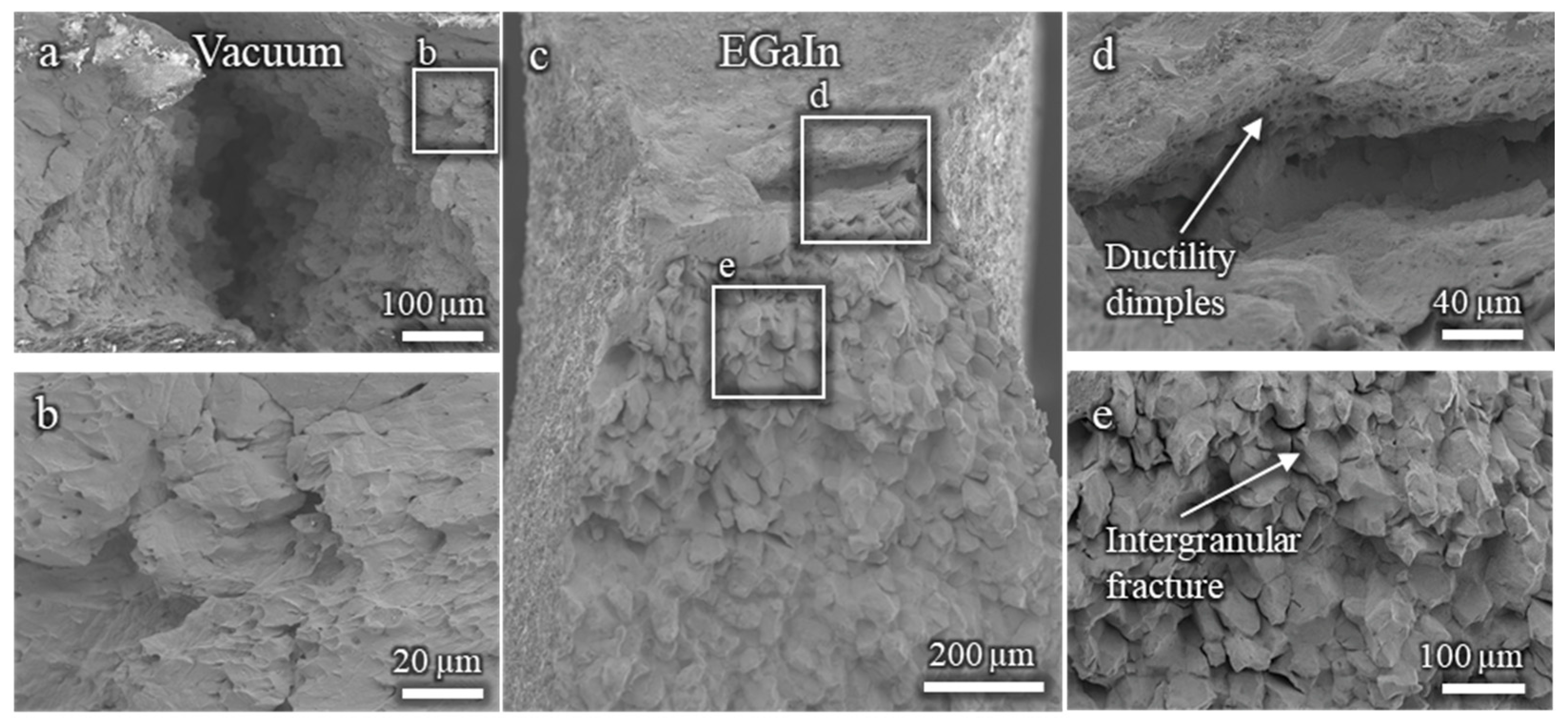
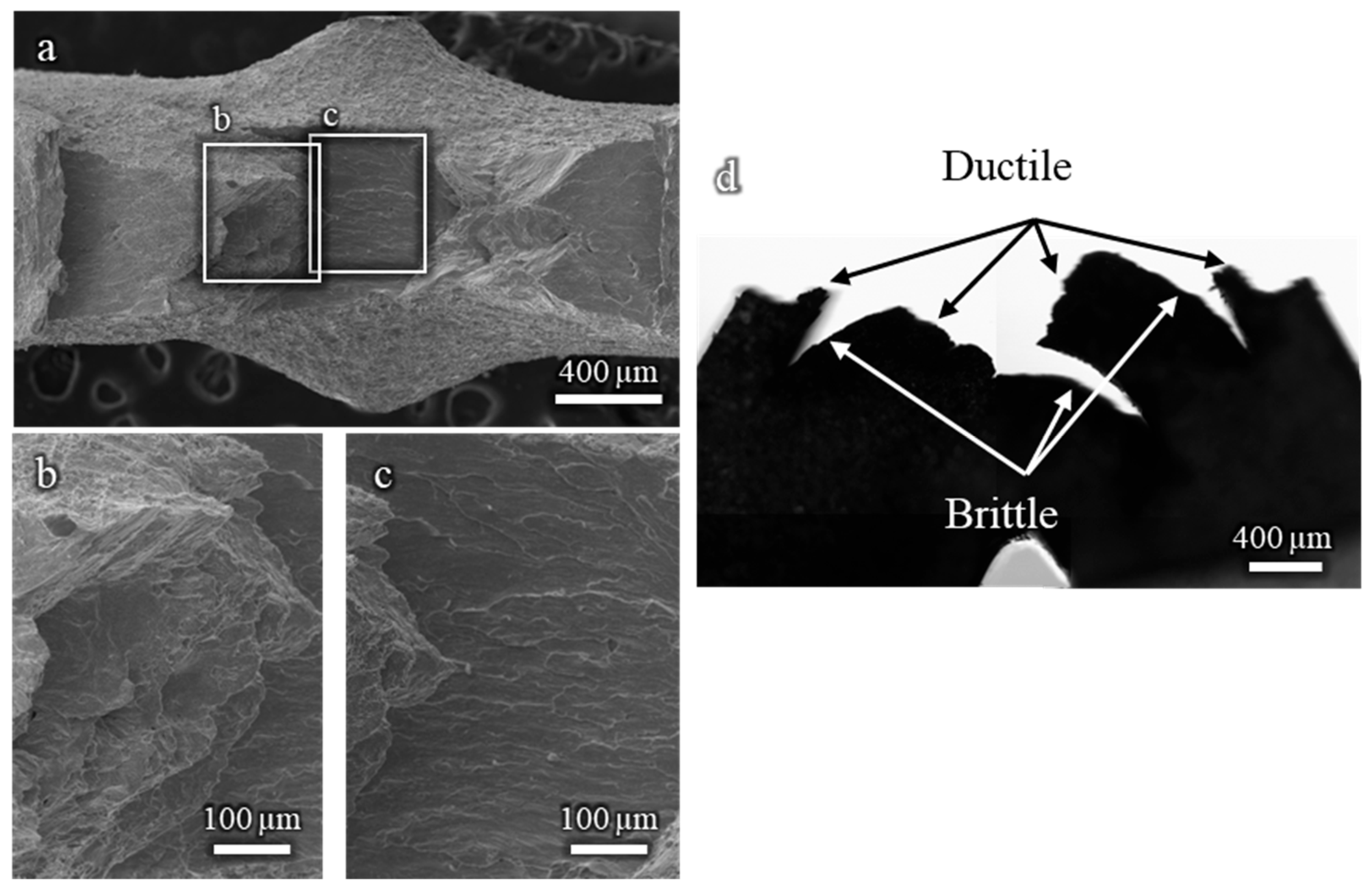
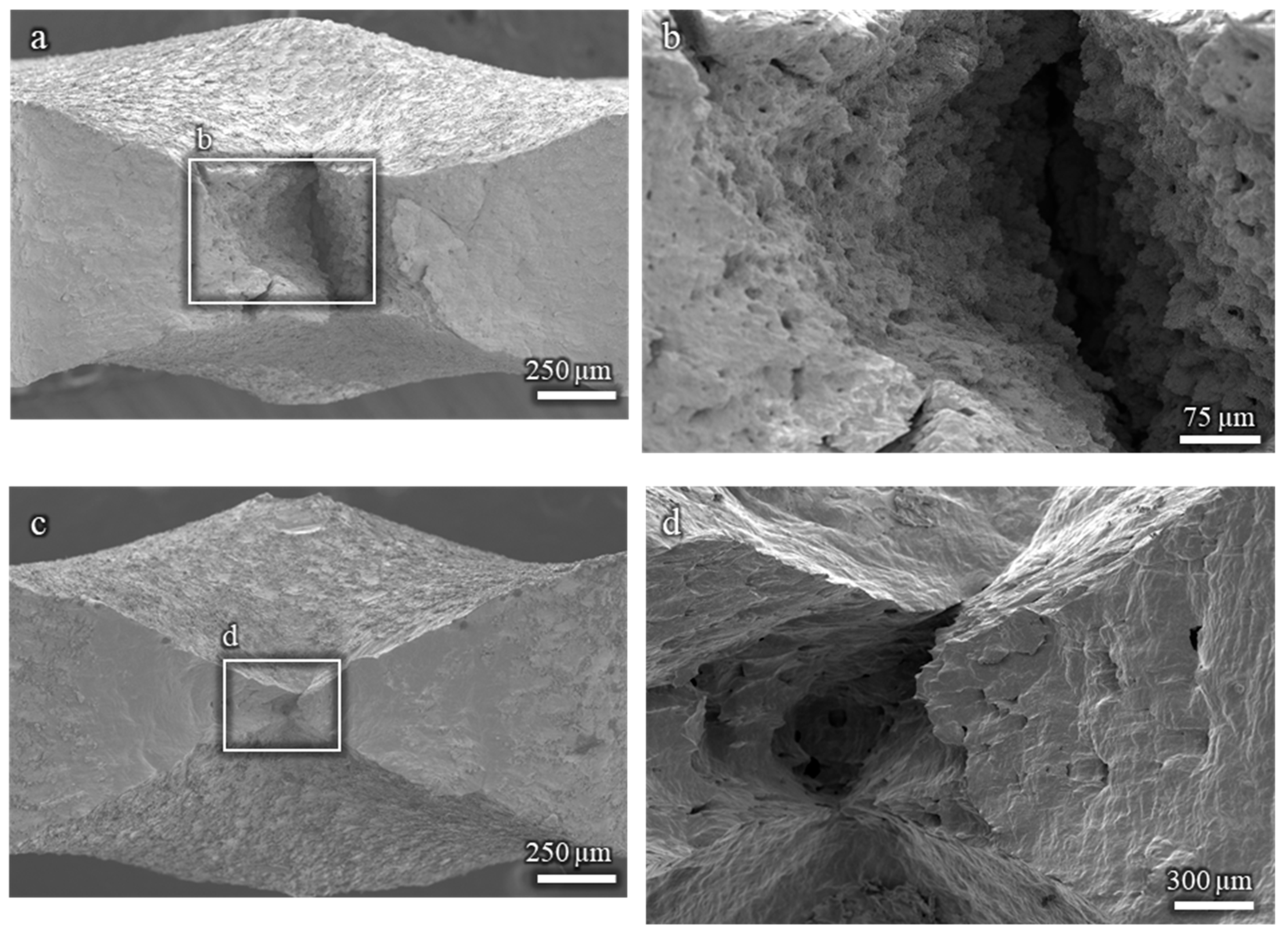
References
- Gong, X.; Short, M.P.; Auger, T.; Charalampopoulou, E.; Lambrinou, K. Environmental degradation of structural materials in liquid lead- and lead-bismuth eutectic-cooled reactors. Prog. Mater. Sci. 2022, 126, 100920. [Google Scholar] [CrossRef]
- Auger, T.; Vogt, J.-B.; Serre, I.P. Liquid Metal Embrittlement. In Mechanics—Microstructure—Corrosion Coupling; Elsevier: Amsterdam, The Netherlands, 2019; pp. 507–534. [Google Scholar] [CrossRef]
- Razmpoosh, M.H.; DiGiovanni, C.; Zhou, Y.N.; Biro, E. Pathway to understand liquid metal embrittlement (LME) in Fe-Zn couple: From fundamentals toward application. Prog. Mater. Sci. 2021, 121, 100798. [Google Scholar] [CrossRef]
- Ludwig, W.; Pereiro-López, E.; Bellet, D. In situ investigation of liquid Ga penetration in Al bicrystal grain boundaries: Grain boundary wetting or liquid metal embrittlement? Acta Mater. 2005, 53, 151–162. [Google Scholar] [CrossRef]
- Joseph, B.; Barbier, F.; Aucouturier, M. Embrittlement of copper by liquid bismuth. Scr. Mater. 1999, 40, 893–897. [Google Scholar] [CrossRef]
- Hojna, A.; Di Gabriele, F.; Klecka, J. Characteristics and Liquid Metal Embrittlement of the steel T91 in contact with Lead-Bismuth Eutectic. J. Nucl. Mater. 2016, 472, 163–170. [Google Scholar] [CrossRef]
- Gong, X.; Marmy, P.; Yin, Y. The role of oxide films in preventing liquid metal embrittlement of T91 steel exposed to liquid lead-bismuth eutectic. J. Nucl. Mater. 2018, 509, 401–407. [Google Scholar] [CrossRef]
- Norkett, J.E.; Dickey, M.D.; Miller, V.M. A Review of Liquid Metal Embrittlement: Cracking Open the Disparate Mechanisms. Metall. Mater. Trans. A 2021, 52, 2158–2172. [Google Scholar] [CrossRef]
- Nicholas, M.G.; Old, C.F. Liquid metal embrittlement. J. Mater. Sci. 1979, 14, 1–18. [Google Scholar] [CrossRef]
- Ezequiel, M.; Serre, I.P.; Auger, T.; Héripré, E.; Hadjem-Hamouche, Z.; Perriere, L. The liquid metal embrittlement of a reactive system at room temperature: α-brasses in contact with the liquid eutectic Ga-In. Eng. Fail. Anal. 2024, 164, 108694. [Google Scholar] [CrossRef]
- Robertson, W.M. Propagation of a Crack Filled with Liquid Metal. Trans. Metall. Soc. AIME 1966, 236, 1478–1482. [Google Scholar]
- Lynch, S.P. Metal-induced embrittlement of materials. Mater. Charact. 1992, 28, 279–289. [Google Scholar] [CrossRef]
- Liu, S.; Sweatman, K.; McDonald, S.; Nogita, K. Ga-based alloys in microelectronic interconnects: A review. Materials 2018, 11, 1384. [Google Scholar] [CrossRef]
- Ling, K.; Kim, H.K.; Yoo, M.; Lim, S. Frequency-switchable metamaterial absorber injecting eutectic gallium-indium (EGaIn) liquid metal alloy. Sensors 2015, 15, 28154–28165. [Google Scholar] [CrossRef]
- Geddis, P.; Wu, L.; McDonald, A.; Chen, S.; Clements, B. Effect of static liquid galinstan on common metals and non-metals at temperatures up to 200 °C. Can. J. Chem. 2020, 98, 787–798. [Google Scholar] [CrossRef]
- Dickey, M.D.; Chiechi, R.C.; Larsen, R.J.; Weiss, E.A.; Weitz, D.A.; Whitesides, G.M. Eutectic gallium-indium (EGaIn): A liquid metal alloy for the formation of stable structures in microchannels at room temperature. Adv. Funct. Mater. 2008, 18, 1097–1104. [Google Scholar] [CrossRef]
- Yu, J.; Yin, S.; Xiong, G.; Guan, X.; Xia, J.; Li, J.; Zhang, S.; Xing, Y.; Yang, P. Controllable Dealloying of a Cu-Ga Alloy and Its Application as an Anode Material for Lithium-Ion Batteries. J. Electrochem. Energy Convers. Storage 2023, 20, 031007. [Google Scholar] [CrossRef]
- Chen, S.; Lin, J.; Yang, T.; Du, Y. Interfacial Reactions in the Cu/Ga/Co and Cu/Ga/Ni Samples. J. Electron. Mater. 2019, 48, 3643–3654. [Google Scholar] [CrossRef]
- Anderson, T.J.; Ansara, I. The Ga-In (Gallium-Indium) System. J. Phase Equilibria 1991, 12, 64–72. [Google Scholar] [CrossRef]
- Kim, D.; Thissen, P.; Viner, G.; Lee, D.W.; Choi, W.; Chabal, Y.J.; Lee, J.B. Recovery of nonwetting characteristics by surface modification of gallium-based liquid metal droplets using hydrochloric acid vapor. ACS Appl. Mater. Interfaces 2013, 5, 179–185. [Google Scholar] [CrossRef] [PubMed]
- Cui, Y.; Liang, F.; Yang, Z.; Xu, S.; Zhao, X.; Ding, Y.; Lin, Z.; Liu, J. Metallic Bond-Enabled Wetting Behavior at the Liquid Ga/CuGa2 Interfaces. ACS Appl. Mater. Interfaces 2018, 10, 9203–9210. [Google Scholar] [CrossRef]
- Froemel, J.; Baum, M.; Wiemer, M.; Gessner, T. Low-Temperature Wafer Bonding Using Solid-Liquid Inter-Diffusion Mechanism. J. Microelectromech. Syst. 2015, 24, 1973–1980. [Google Scholar] [CrossRef]
- Liu, S.; McDonald, S.; Gu, Q.; Matsumura, S.; Qu, D.; Sweatman, K.; Nishimura, T.; Nogita, K. Properties of CuGa2 Formed Between Liquid Ga and Cu Substrates at Room Temperature. J. Electron. Mater. 2020, 49, 128–139. [Google Scholar] [CrossRef]
- Lin, S.; Cho, C.; Chang, H. Interfacial Reactions in Cu/Ga and Cu/Ga/Cu Couples. J. Electron. Mater. 2014, 43, 204–211. [Google Scholar] [CrossRef]

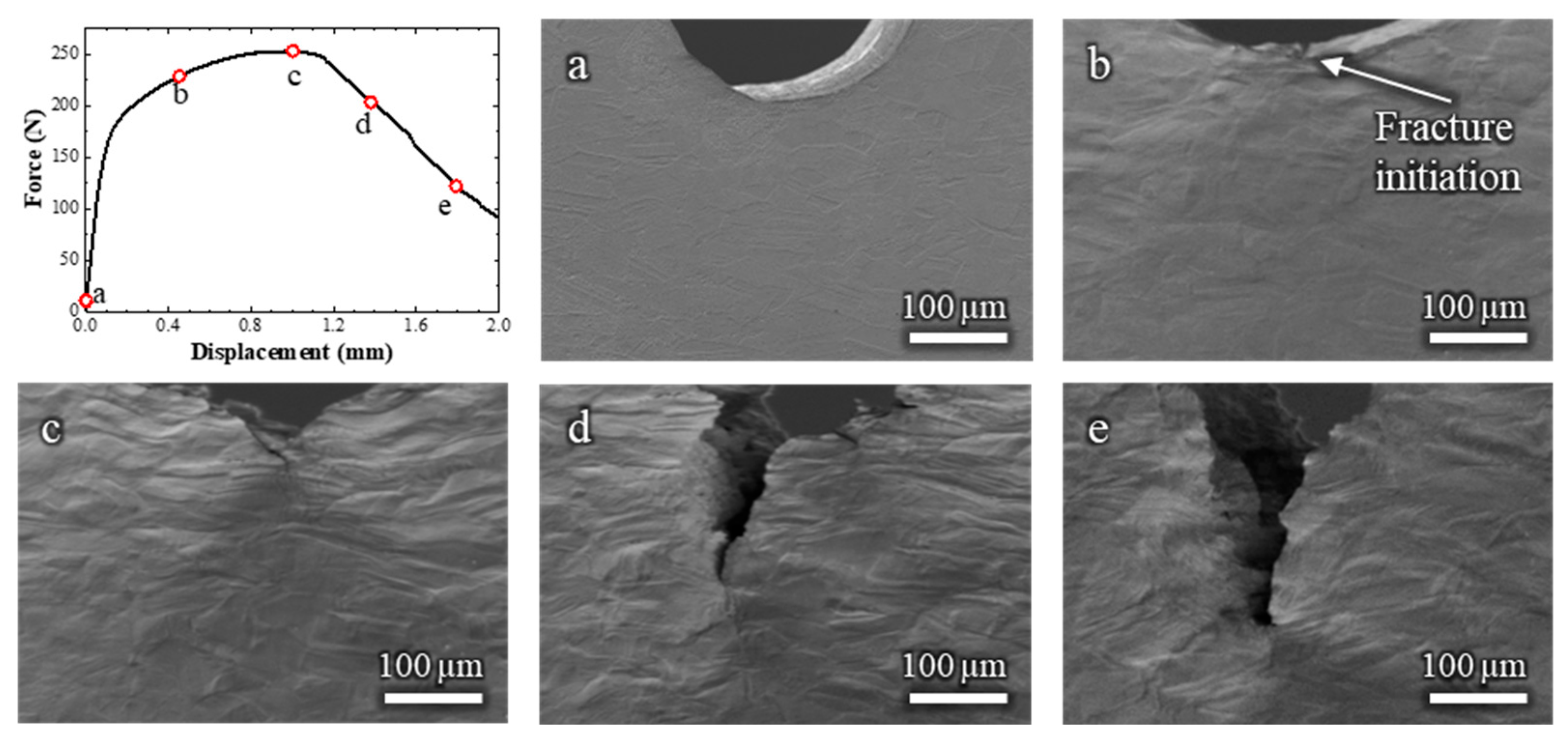
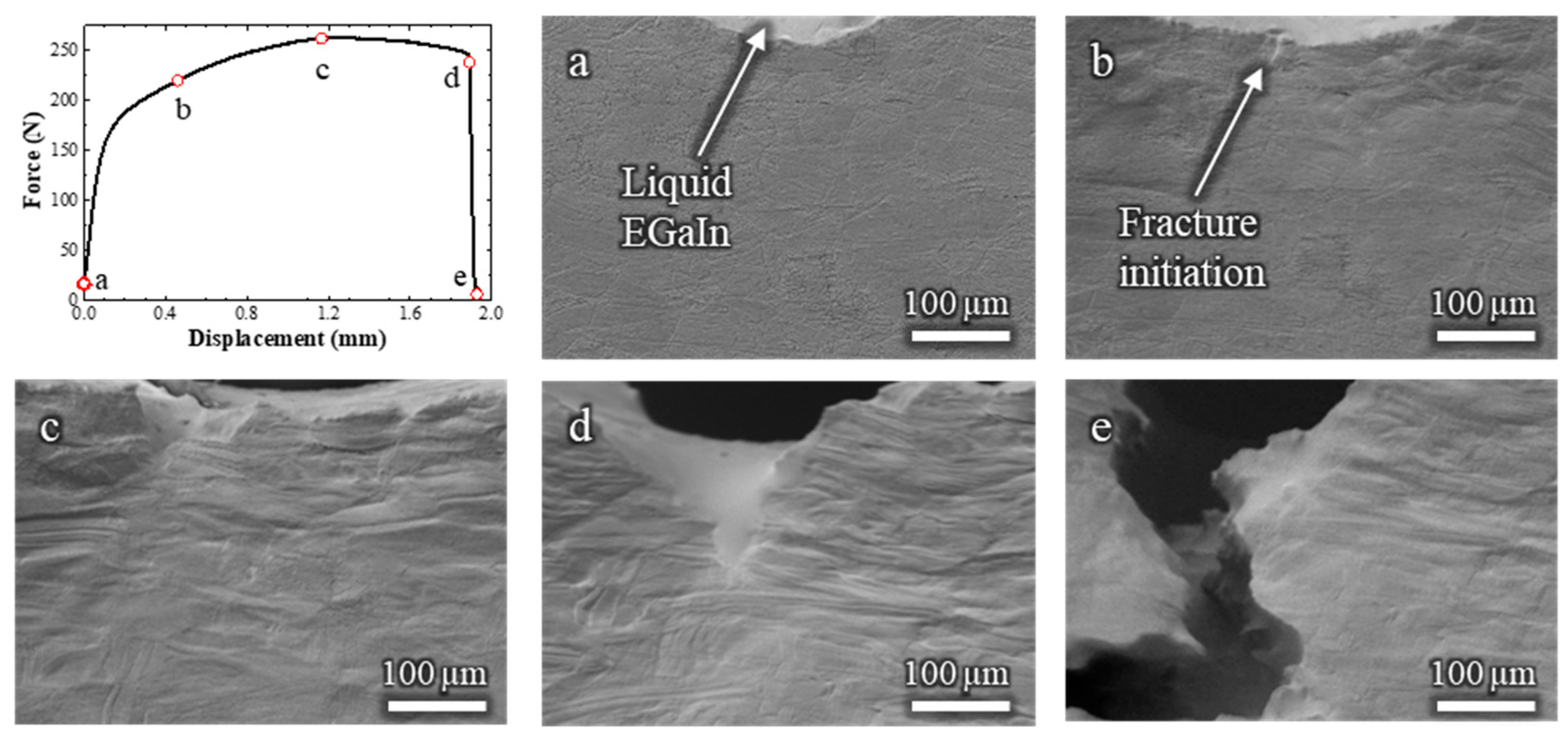
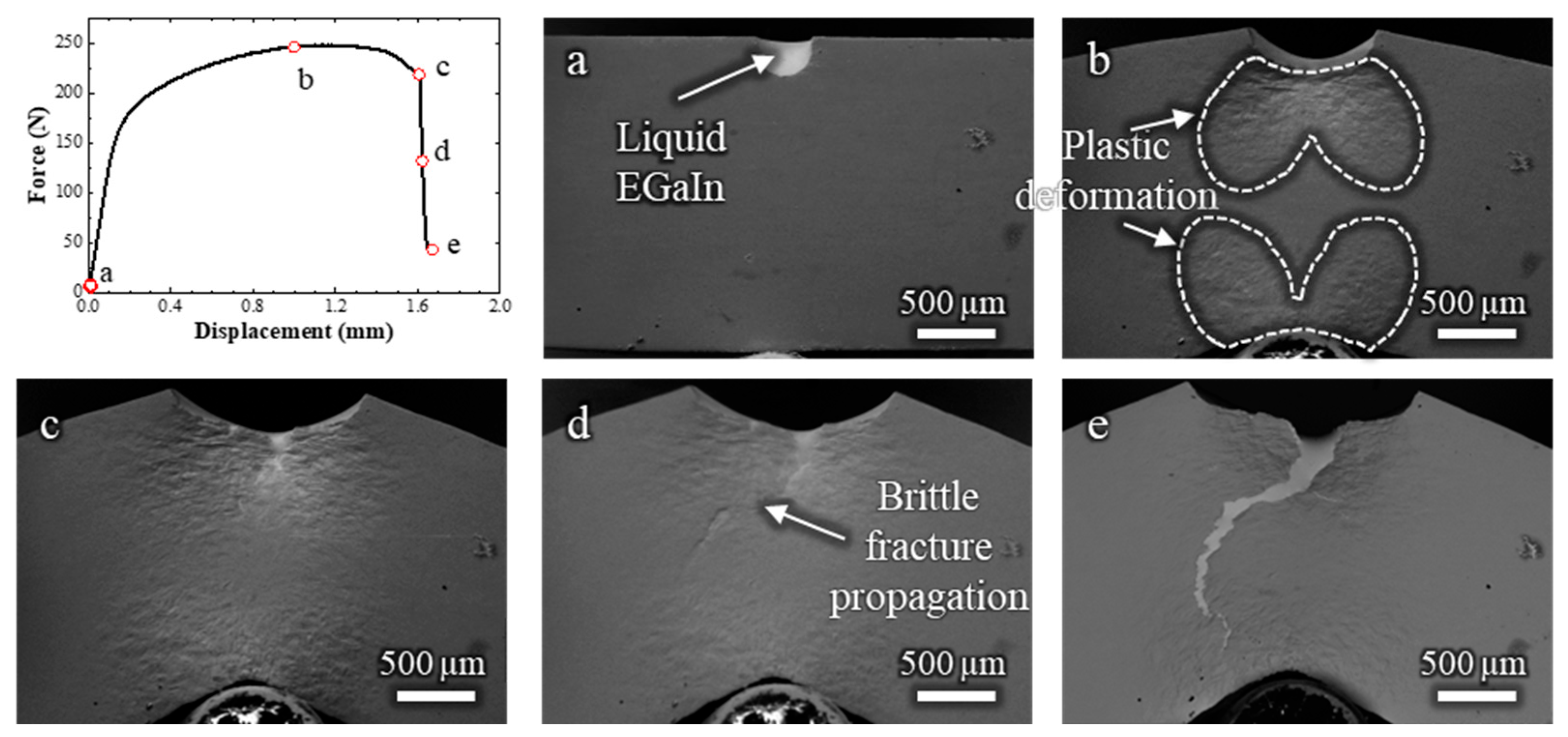
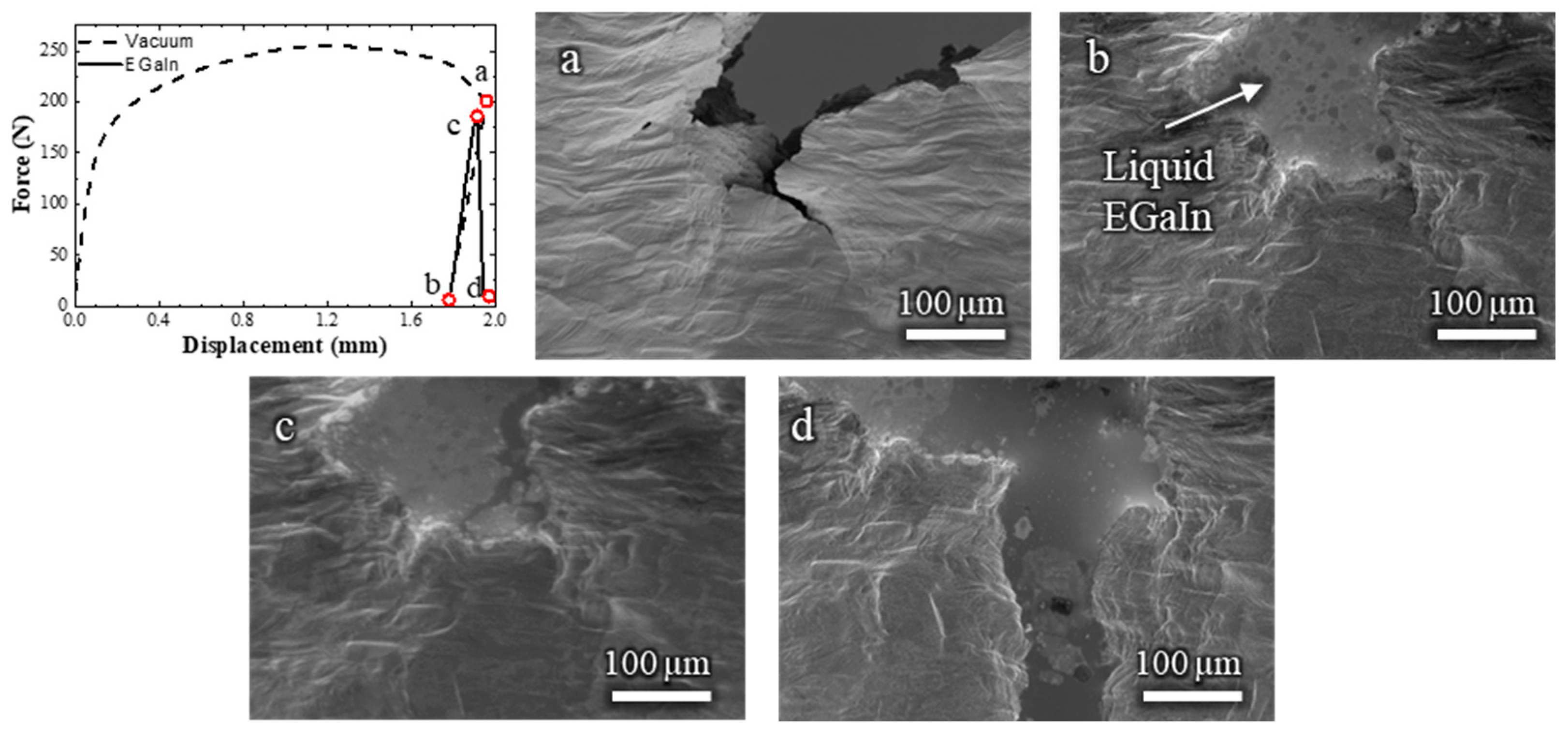
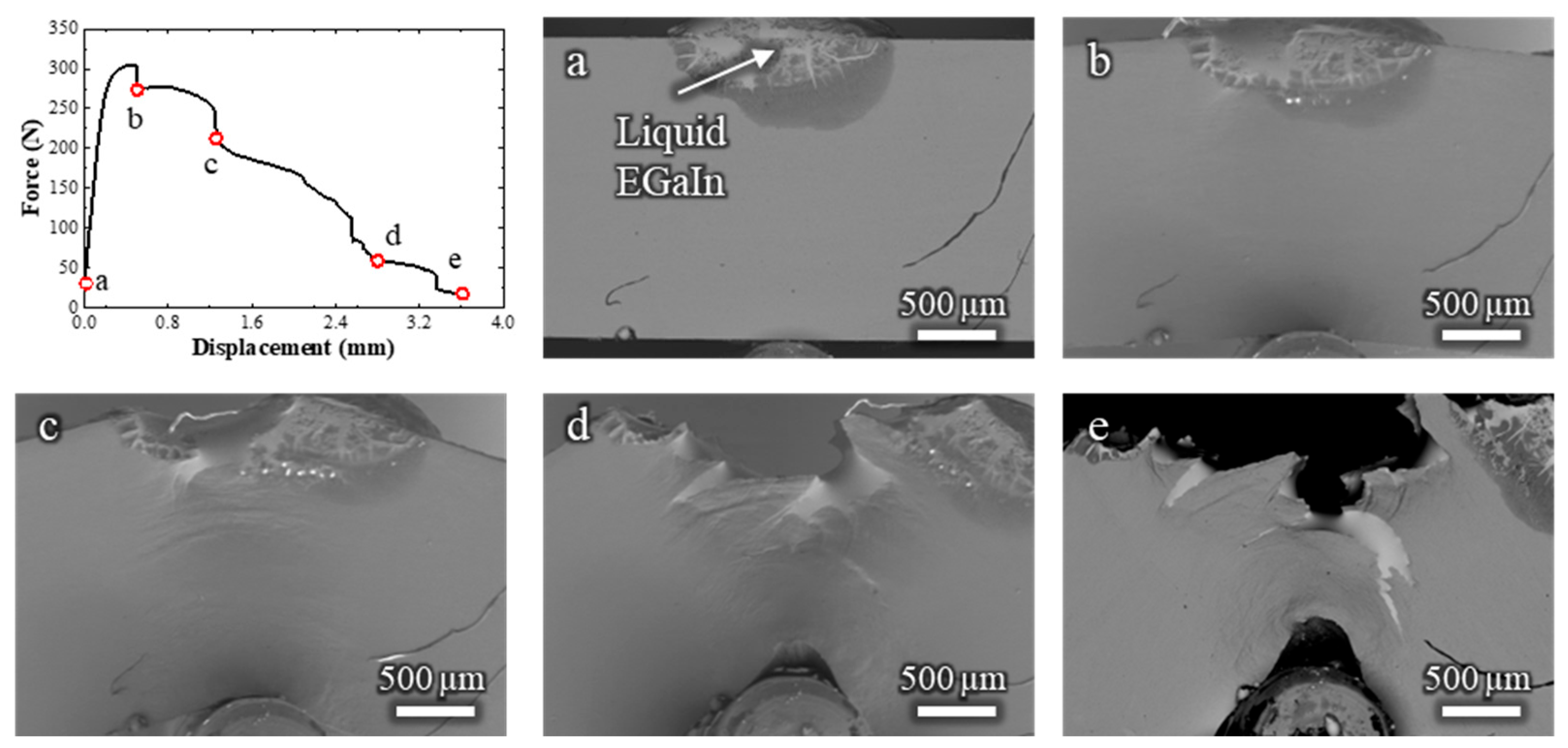
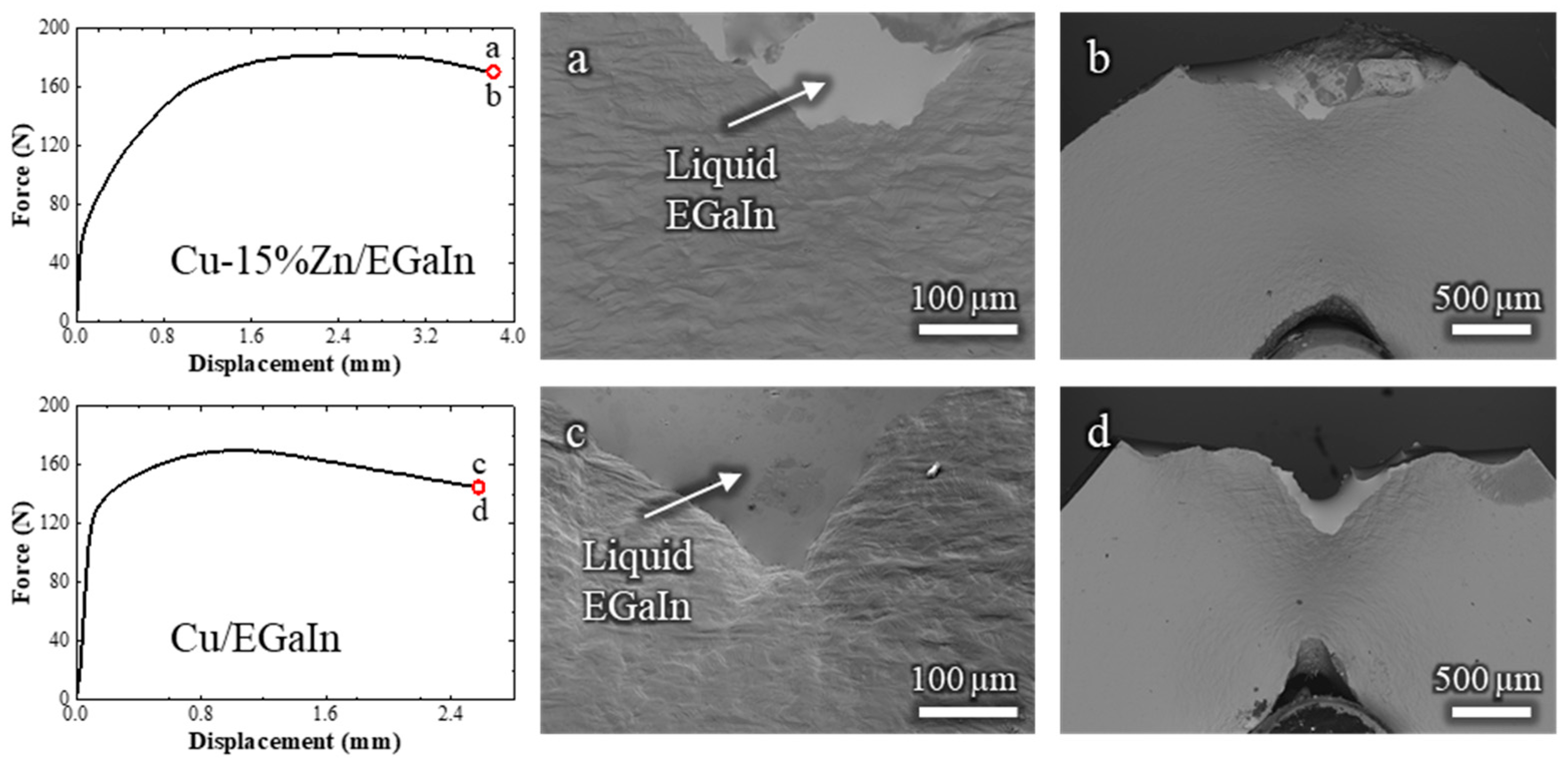
| Material | Hardness (HV) | Grain Size (µm) |
|---|---|---|
| Cu | 100 ± 3 | 21 ± 3 |
| Cu-15%Zn | 75 ± 3 | 20 ± 3 |
| Cu-20%Zn | 212 ± 15 | * |
| Cu-30%Zn | 142 ± 4 | 39 ± 7 |
Disclaimer/Publisher’s Note: The statements, opinions and data contained in all publications are solely those of the individual author(s) and contributor(s) and not of MDPI and/or the editor(s). MDPI and/or the editor(s) disclaim responsibility for any injury to people or property resulting from any ideas, methods, instructions or products referred to in the content. |
© 2025 by the authors. Licensee MDPI, Basel, Switzerland. This article is an open access article distributed under the terms and conditions of the Creative Commons Attribution (CC BY) license (https://creativecommons.org/licenses/by/4.0/).
Share and Cite
Ezequiel, M.; Proriol Serre, I.; Fadel, A. In Situ SEM Observations of the Liquid Metal Embrittlement of α-Brasses in Contact with the Liquid Ga-In Eutectic at Room Temperature. Metals 2025, 15, 1194. https://doi.org/10.3390/met15111194
Ezequiel M, Proriol Serre I, Fadel A. In Situ SEM Observations of the Liquid Metal Embrittlement of α-Brasses in Contact with the Liquid Ga-In Eutectic at Room Temperature. Metals. 2025; 15(11):1194. https://doi.org/10.3390/met15111194
Chicago/Turabian StyleEzequiel, Marco, Ingrid Proriol Serre, and Alexandre Fadel. 2025. "In Situ SEM Observations of the Liquid Metal Embrittlement of α-Brasses in Contact with the Liquid Ga-In Eutectic at Room Temperature" Metals 15, no. 11: 1194. https://doi.org/10.3390/met15111194
APA StyleEzequiel, M., Proriol Serre, I., & Fadel, A. (2025). In Situ SEM Observations of the Liquid Metal Embrittlement of α-Brasses in Contact with the Liquid Ga-In Eutectic at Room Temperature. Metals, 15(11), 1194. https://doi.org/10.3390/met15111194







